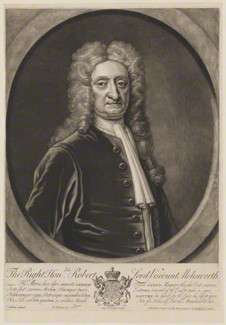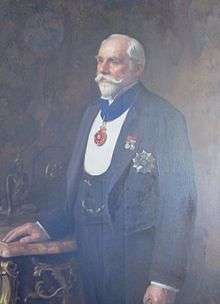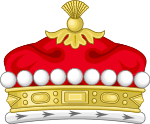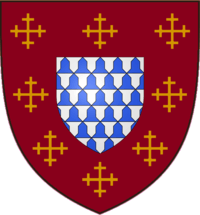Robert Molesworth, 1st Viscount Molesworth
Robert Molesworth, 1st Viscount Molesworth PC (Ire) (7 September 1656 – 22 May 1725) was an Irish politician and writer.
The Viscount Molesworth | |
|---|---|
 Robert Molesworth, 1st Viscount Molesworth - by Peter Pelham, mezzotint, 1721 | |
| Member of Parliament for Dublin County with Edward Deane | |
| In office 1695–1703 | |
| Preceded by | John Allen Chambre Brabazon |
| Succeeded by | John Allen Joseph Deane |
| Member of Parliament for Swords with James Peppard (1703–1713) Plunket Plunket (1713–1715) | |
| In office 1703–1715 | |
| Preceded by | Thomas Ashe John Reading |
| Succeeded by | Richard Molesworth Plunket Plunket |
| Member of Parliament for Camelford with Ambrose Manaton (1695–1696) Sidney Wortley Montagu (1696–1698) | |
| In office 1695–1698 | |
| Preceded by | Ambrose Manaton Henry Manaton |
| Succeeded by | Henry Manaton Dennys Glynn |
| Member of Parliament for Lostwithiel with Russell Robartes | |
| In office 1705–1706 | |
| Preceded by | Sir John Molesworth Russell Robartes |
| Succeeded by | Russell Robartes James Kendall |
| Member of Parliament for East Retford with Sir Hardolph Wastneys | |
| In office 1706–1707 | |
| Preceded by | Sir Willoughby Hickman William Levinz |
| Succeeded by | Parliament of Great Britain |
| Member of Parliament for East Retford with Sir Hardolph Wastneys | |
| In office 1707–1708 | |
| Preceded by | Parliament of England |
| Succeeded by | William Levinz Thomas White |
| Member of Parliament for Mitchell with Nathaniel Blakiston | |
| In office 1715–1722 | |
| Preceded by | Sir Henry Belasyse John Statham |
| Succeeded by | Charles Selwyn John Hedges |
| Personal details | |
| Born | 7 September 1656 Brackenstown, Swords, Ireland |
| Died | 22 May 1725 (aged 68) Dublin, Ireland |
| Spouse(s) | Hon. Letitia Coote |
| Children | John Molesworth, 2nd Viscount Molesworth Richard Molesworth, 3rd Viscount Molesworth Hon. Robert Molesworth (I) Hon. William Molesworth Hon. Edward Molesworth Hon. Coote Molesworth (I) Hon. Robert Molesworth (II) Hon. Hamilton Walter Molesworth Hon. Coote Molesworth (II) Hon. Bysse Molesworth Hon. Robert Molesworth (III) Hon. Margaret Molesworth Hon. Mary Molesworth Hon. Letitia Molesworth (I) Hon. Charlotte Molesworth Hon. Letitia Molesworth (II) |
| Parents | Robert Molesworth Judith Bysse |
| Alma mater | Trinity College, Dublin (1675, B.A.) |
Molesworth came of an old Northamptonshire family. He married Hon. Letitia Coote, daughter of Richard Coote, 1st Baron Coote, and Mary St. George. His father Robert (d. 1656) was a Cromwellian who made a fortune in Dublin, largely by provisioning Cromwell's army; Robert Molesworth the younger supported William of Orange and was made William's ambassador to Denmark. In 1695 he became a prominent member of the Privy Council of Ireland. The same year he stood for Dublin County in the Irish House of Commons, a seat he held until 1703. Subsequently, he represented Swords until 1715. In the following year, he was created Viscount Molesworth, of Swords, in the Peerage of Ireland.
Molesworth's An Account of Denmark, as it was in the Year 1692 (published 1694) was somewhat influential in the burgeoning field of political science in the period. He made a case for comparative political analysis, comparing the political situation of a country to the health of an individual; a disease, he reasoned, can only be diagnosed by comparing it to its instantiation in other people (Thompson, 495).
Life and career
Robert Molesworth was born two days after his fathers' death on 9 September 1656; his mother Judith Bysse later remarried Sir William Tichborne of Beaulieu. He was probably raised by his mothers' family, the Bysses, at Brackenstown, near Swords, County Dublin. His grandfather, John Bysse, was an eminent lawyer who became Chief Baron of the Irish Exchequer under Charles II. In 1675, Robert graduated from Trinity College, Dublin with a B.A.. On 15 August 1676, shortly before his 20th birthday, he was married in Dublin to Letitia Coote, third daughter of Richard Coote (1620–1683), 1st Baron Coote of Colooney, and Mary St. George, daughter of George St. George, Deputy Admiral of Connaught. Letitia's brother Richard was created Earl of Bellomont and served as Governor of New York, Massachusetts and New Hampshire for William III from 1697 until his sudden death in 1701. Robert and Letitia Molesworth subsequently settled at the Bysse family seat, Brackenstown House, where according to a letter of 1721 Letitia bore seventeen children, nine of whom were still living at the time.
On 7 May 1689, young Molesworth, an active supporter of the Williamites, was attainted by King James II's Catholic-dominated Irish Parliament. His estate, valued at £2825 per annum, was duly confiscated. James had succeeded his brother Charles II as king of England, Ireland and Scotland early in 1685. Although initially fearful of alienating English and Irish Protestant opinion, James came under the influence of the Catholic Richard Talbot, 1st Earl of Tyrconnell and determined to make the island of Ireland a Catholic stronghold. Tyrconnell also secured the king's agreement to revise the 1662 Act of Settlement, which had confirmed many of the leading Cromwellian planters in their estates. Over the course of the next two years, war raged across Ireland between the rival armies of James II and the Dutch Protestant, William of Orange, who was invited to take the throne of England by the Parliament in 1688. The decisive victory of the Williamite forces at the battle of the Boyne in 1690, and the battle of Aughrim in 1691, confirmed the new Protestant monarchy and finally secured New English interests in Ireland. The age of the Protestant Ascendancy had begun.
Robert Molesworth, an ardent Whig, became a prominent figure in the new Williamite administration. Contemporaries acknowledged his opinions on politics and economy with considerable respect. From July 1689 to December 1692 he served as British Ambassador to the Court of Denmark, during which time he wrote a spirited attack on Danish absolutism in a treatise entitled An Account of Denmark as it was in the Year 1692. From 1695 to 1698 he stood as Whig MP in both the English and Irish Parliaments, representing Camelford and Dublin City respectively. In August 1697, he was appointed to the Irish Privy Council, an effective cabinet charged with the governance of Ireland and the introduction of the "Penal Laws". From 1703 to 1715 he represented Swords as MP in the Irish Parliament. Between November 1714 and December 1715 he served in the fruitful post of Commissioner of Trade and Plantations.
On 16 July 1716, Robert was advanced to the Irish peerage as Baron of Phillipstown and Viscount Molesworth of Swords "in reward for his steadfast adherence to the House of Hanover". He took his seat as such on 1 July 1719. In his later years he established the "Molesworth Circle", a group of eminent scientists, philosophers and thinkers who met at Brackenstown and are said to have introduced the spread of "politeness" in 18th century Ireland. Other members of this Whig-minded intellectual circle included Anthony Ashley Cooper, 3rd Earl of Shaftesbury, Francis Hutcheson, James Arbuckle, John Toland and Jonathan Swift. Molesworth's pamphlet Considerations on the Agriculture and Employment of the Poor of Ireland prompted Swift to address the last of his celebrated Drapier's Letters to Molesworth in 1724.
When the so-called South Sea Bubble burst in 1720, the 1st Viscount was perhaps the most vehement of those seeking vengeance against the company directors. He and his grandson, Robert Molesworth, had invested heavily in the company. He advised that, as no law existed for punishing such companies, the government "ought upon this occasion follow the example of the ancient Romans, who, having no law against parricide, because their legislators supposed no son could be so unnaturally wicked as to embrue his hands in his father's blood, made a law to punish this heinous crime as soon as it was committed. They adjudged the guilty wretch to be sewn into a sack and thrown alive into the Tiber". The Whig statesman declared that he would be quite "satisfied to see [the South-Sea Company directors] tied in like manner in sacks, and thrown into the Thames."
Family
With his wife Letitia, Molesworth had eleven sons and six daughters:[1][2]

- John Molesworth, 2nd Viscount Molesworth of Swords (4 December 1679 - 17th or 18 February 1725/26). Ambassador at the Court of Tuscany and Sardinia in 1710 and 1720. He married Mary, daughter and co-heir of Thomas Middleton Esq. of Stansted Montfitchet, Essex, by whom he had a posthumous daughter Mary, who married Frederick Gore Esq., M.P.
- Field Marshal Richard Molesworth, 3rd Viscount Molesworth of Swords (1680/1 - 12 October 1758). Aide-de-Camp to the Duke of Marlborough at the Battle of Ramilles, where he saved the Duke's life. He later became a General and rose to Fieldmarshal.
- He married 1stly Jane Lucas and had 3 daughters:
- Mary (wife of Robert Rochfort, 1st Earl of Belvedere).
- Letitia (wife of Lt. Colonel James Molesworth).
- Amelia (died unm 30 Jan 1758)
- Richard married 2ndly Mary, daughter of Rev. William Usher, Archdeacon of Clonfert and had a son and six daughters:
- Richard Nassau Molesworth (4th Viscount)
- Henrietta (wife of Rt. Hon John Staples of Lissan House, Co. Londonderry. Their daughter Charlotte married William Lenox-Conyngham of Springhill, Co. Londonderry, father of Sir William Fitzwilliam Lenox-Conyngham).
- Louisa (wife of William Ponsonby, 1st Baron Ponsonby, then William Fitzwilliam, 4th Earl Fitzwilliam)
- Charlotte
- Elizabeth (wife of James Stewart Esq. of Killymoon)
- and Mary & Melosina who tragically died with their mother in the fire at their London house, 6th May 1763.
- Hon. Robert Molesworth I (living in 1688)
- Captain The Hon. William Molesworth (1688 - ), MP for Philipstown. His son Robert became 6th Viscount Molesworth. Married Anne, eldest daughter of Robert Adair Esq. of Holybrook, Co. Wicklow.
- Major The Hon. Edward Molesworth (born c.1689, died 29 November 1768). Married firstly, Sept 1718 Catherine Middleton, daughter of Thomas Middleton, with whom he had a son Robert. Edward married as his second wife Mary Renouard and had a son John (d.1791). John's son was the Rev. John Molesworth (d.1877), whose sons included Sir Guildford Lindsey Molesworth (d. 1925) and solicitor John Molesworth (d.1886), the grandfather of Margaret Patricia Molesworth (1904–1985) who is the grandmother of Sophie, Countess of Wessex. Another son was the Rev. Rennell Molesworth (died 1906), grandfather of Lady Mogg née Margaret Molesworth (born 1914).[3][4][5][6][7][8][9]
- Hon. Coote Molesworth I (born c.1689 - )
- Hon. Robert Molesworth II (born c.1692)
- Hon. Walter Molesworth (born after 1692, between Robert II and Letitia II, died 1773). He left children.
- Hon. Coote Molesworth II M.D. (born 1698, died 9 November 1782)
- Hon. Bysse Molesworth (born 1700, died 1779). Married 7th Dec 1731, Elizabeth Cole, sister of John Cole, 1st Baron Mountflorence and widow of Edward Archdall Esq. of Castle Archdall, Co. Fermanagh.
- Hon. Robert Molesworth III (born c.1702, died aged c.10 of smallpox)
- Hon. Juliana Molesworth (died unm 1759)
- Hon. Margaret Molesworth (1677 - 1684)
- Hon. Mary Molesworth (1682 - 1716), a celebrated beauty and poet. Married George Monk Esq. of Dublin.
- Hon Letitia Molesworth I (living in 1688)
- Hon. Charlotte Amelia Molesworth (born c.1691 - ). Married Capt. William Tichborne, younger son of Henry Tichborne, 1st Baron Ferrard who was her cousin on the Bysse side
- Hon Letitia Molesworth II (born 7th or 8 March 1697). Married Edward Bolton Esq. of Brazeel, Co. Dublin
Robert also appears to have had a natural son:
- John Phillips of Swords, Co. Dublin. His son was Molesworth Phillips who sailed with Captain Cook.

Death and succession
The 1st Viscount died in Dublin on 22 May 1725 at the age of sixty-nine and was buried in Swords. His widow, Letitia, died "of a great cold" on St Patrick's Day 1729 and was buried privately in St. Audoen's Church Dublin. Their eldest son, John, succeeded as 2nd Viscount Molesworth in 1725. John, in turn, was succeeded by his younger brother Richard a year later in 1726.
Arms
  |
|
References
- Children of the 1st Viscount Molesworth - William Molesworth, MA (Cantab), MLitt (Dub)
- A Genealogical and Heraldic Dictionary of the Peerage and Baronetage of the British Empire, by Sir Bernard Burke. 1869 Edition, published by Harrison, 59 Pall Mall.
- Burke's Peerage, Baronetage & Knightage, 107th edition, volume 2, 2003. pages 2721–2731.
- "Good Gentlewoman - Henrietta, Louisa and Elizabeth Molesworth". Wordpress.com - 2 September 2014. Retrieved 3 September 2017.
- "Debrett's Peerage and Baronetage - 2011". Debrett's Peerage Limited, 2011. Retrieved 25 August 2017.
....Cecilia Margaret (Lady Mogg) Church Close Cottage, Watlington, Oxon,.... b 1914; m 1939, Gen Sir Herbert John Mogg, .... Grandchildren of the late Rev. Rennell Francis Wynn Molesworth, son of the .....John (Molesworth).... Lawrence Teesdale... Margaret Patricia Newell... Sophie Helen....
- Mogg, Lady Margaret. "Watlington was always home". wordpress.com.
I learned to ride a horse age 8 or 9 years old.... went out horseriding together...we had (three) sons....
- "Edward and Sophie". Australian Women's Weekly NZ - 1 October 2016. 1 October 2016.
The problem for those around the Queen's youngest child is that his ... They (the Queen and Sophie, Countess of Wessex) have a shared passion for horses and military history and, despite...
- "Sophie's Brush With Greatness". Manchester Evening - News 22 January 2013. Retrieved 26 August 2018.
Rochdale solicitor's firm Molesworth, Bright and Clegg. The firm was set up in 1840 by John Molesworth, one of the vicar's sons and Sophie's great-great grandfather.
- "The Solicitors' Journal and Reporter, Volume 14". Law Newspaper Company, 1870 -. p. 280. Retrieved 27 August 2018.
Mr John Molesworth, solicitor ...has been elected one of the County Coroners for ....
- http://www.cracroftspeerage.co.uk/online/content/molesworth1716.htm
- http://www.turtlebunbury.com/history/history_houses/hist_hse_29molesworth.html
- Thompson, Martyn P. "A Note on "Reason" and "History" in Late Seventeenth Century Political Thought." Political Theory, Vol. 4, No. 4. (1976), 491–504.
| Parliament of Ireland | ||
|---|---|---|
| Preceded by John Allen Chambre Brabazon |
Member of Parliament for Dublin County 1695–1703 With: Edward Deane |
Succeeded by John Allen Joseph Deane |
| Preceded by Thomas Ashe John Reading |
Member of Parliament for Swords 1703–1715 With: James Peppard 1703–1713 Plunket Plunket 1713–1715 |
Succeeded by Richard Molesworth Plunket Plunket |
| Parliament of England | ||
| Preceded by Ambrose Manaton Henry Manaton |
Member of Parliament for Camelford 1695–1698 With: Ambrose Manaton 1695–1696 Sidney Wortley Montagu 1696–1698 |
Succeeded by Henry Manaton Dennys Glynn |
| Preceded by Sir John Molesworth Russell Robartes |
Member of Parliament for Lostwithiel 1705–1706 With: Russell Robartes |
Succeeded by Russell Robartes James Kendall |
| Preceded by Sir Willoughby Hickman William Levinz |
Member of Parliament for East Retford 1706–1707 With: Sir Hardolph Wastneys |
Succeeded by Parliament of Great Britain |
| Parliament of Great Britain | ||
| Preceded by Parliament of England |
Member of Parliament for East Retford 1707–1708 With: Sir Hardolph Wastneys |
Succeeded by William Levinz Thomas White |
| Preceded by Sir Henry Belasyse John Statham |
Member of Parliament for Mitchell 1715–1722 With: Nathaniel Blakiston |
Succeeded by Charles Selwyn John Hedges |
| Peerage of Ireland | ||
| New creation | Viscount Molesworth 1716–1725 |
Succeeded by John Molesworth |